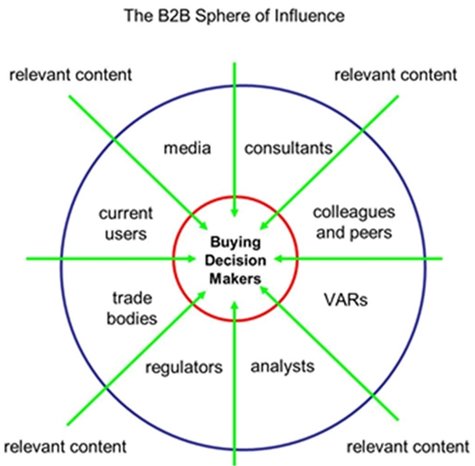In our B2B marketing guidebook Business-to-Business Marketing: A Step-by-Step Guide, published by Penguin Random House, my co-author Charlie Stewart and I write, "The purpose of B2B marketing is to attract and retain profitable customers."
The first step toward achieving that goal is to know who influences buying decisions—and then win their sale-creating trust.
The first of this short series of articles offers straightforward guidance on how to...
- Identify the buying-decision influencers in your market.
- Define how your offering contributes to their success and their organization's success.
- Create decision-influencer personas that focus on securing buying decisions.
B2B markets are complex structures. That's because the decisions that generate sales—what to buy, from whom, and at what price—are typically influenced by many people. Identifying all these influencers is the first step toward convincing buyers to trust their decisions—and buy from you.
Who's Who in Your Market? Understanding Market Composition
Before even thinking about issues like content, or the communication channels to deliver it, or contact points within the B2B buying cycle, or measuring returns on marketing spend, you must first identify who's who in your market.
Skip this first step—or wing it using entrenched assumptions—and there's no point in taking the next step: providing all the decision influencers with content that wins sales-creating trust.
This simple graphic illustrates some of the typical components of a B2B market:

Within the Sphere, influencers fall into two categories: external and internal.
- External influencers might include industry analysts, specialist consultancies, commentators in the media, distributors, value-added resellers, and peer-to-peer influencers—typically people who are (hopefully) willing to recommend a supplier based on their experience as a customer.
- Within customers, internal influencers may represent finance, strategy, business analysis, production, marketing, sales, HR, project management, R&D, after-sales support, and specific users of the products and services being considered.
For major purchases—the ones that create major sales—people from different internal functions may come together as a decision-making unit, and they might be joined by external advisers engaged for their specific expertise.
Decision Influencers Have Two Objectives, Which Are Always the Same
When considering buying decisions, all influencers share two common objectives:
- First, they need to trust that their professional responsibilities will be fulfilled.
- Second, they need to trust that their decision will benefit their organization.
You must therefore demonstrate how your products and services will contribute specifically to the success of each influencer and to the success of their enterprise. You need to provide evidence that will prove the two objectives will be met. It must be evidence—not hollow propaganda in which "the large print giveth and the small print taketh away" (Tom Waits, "Step Right Up" from the album Small Change).
That evidence—and that evidence alone—should form the basis for content. Content that proves your offering will fulfil each influencer's objectives: Buying this will be good for me and my organization.
If your content achieves that goal, then the combined weight of all the influence within the Sphere will support a unanimous decision to buy from you.
Influencer-Based Personas: A focus on Securing Buying Decisions
Harnessing support across the Sphere requires a mechanism to keep tabs on influencers, including on how they and their objectives may change. Because the buying environment does change: Influencers move on, and needs alter in response to economic circumstances or as a result of, say, technological advances and how they are applied.
Influencer-based personas provide this mechanism in the form of a straightforward fact file that records information about everyone who affects the buying decision—such as who they are and what they do. Much more importantly, such personas should define the boxes each influencer needs to tick in support of a buying decision. Based on that information, content can then be tailored to address the particular needs of everyone within your Sphere.
Considering the multiple decision influencers within an overall B2B market, content that falls into the one-size-fits-all category is not likely to be very effective. "Brighter than Bright" may help to sell BriteRite washing powder to shoppers in a supermarket, but "Just Dig It" won't sell many earthmovers to roadbuilders.
Accordingly, the process of creating sales-generating content can begin only once there is an accurate understanding of who's who in the overall market.
Identify the Heavyweights in Your Sphere
"Don't count the people that you reach, reach the people who count."
David Ogilvy's guiding remark about effective advertising also highlights that some influencers count more than others. It makes sense to identify the heavyweights in your Sphere and ensure that they have the fullest possible understanding of how your organization meets their specific requirements.
It's hardly surprising that commentators in the media, across multiple formats, can carry heavyweight influence throughout the Sphere. In 2014, the Economist published a survey on the effectiveness of content marketing from the perspective of the audiences being addressed: Articles, research reports, and briefing papers were the most helpful forms of content for executives searching for information about a business-related need, the survey found.
Clearly, it's sensible to identify respected media titles and their writers, and to engage them on topics relating to your offerings that will interest them and their readers.
In addition to the media, two other heavyweights are consultants and peer-to-peer influencers:
- If their function involves specifying products and services on behalf of clients, consultants and professional advisers can exert enormous influence on a buying decision.
- When existing customers recommend your organization by describing how it contributes to their success, they can be compelling advocates in the decision-making process.
Win Sales-Creating Trust: Define How Every Influencer Benefits
As part of the process that simplifies the complexity of B2B markets, you need to understand what type of content will meet the objectives for each influencer within the Sphere.
For example, reliability may be just one of many benefits produced by your offering, perhaps translating into low maintenance costs or increased productivity through reduced downtime. Maybe it improves day-to-day operational efficiency or strengthens the integrity of processes.
Reliability might produce all these benefits and more. Great! But who benefits and how? How does reliability make a contribution that's relevant to a value-added reseller's success? For end-users, what requirements does it fulfill? And why would reliability motivate a consultant's recommendation, or persuade an industry analyst or media commentator to express a positive opinion?
When specific benefits delivered by your products and services are trusted to meet the specific objectives of all the influencers in an overall market, there's logically a high probability of creating profitable sales. That's because everyone who matters trusts that the right decision is being made about what to buy, from whom, and at what price.
In the next article in this series, I'll discuss content and the buying-decision cycle—how to guarantee your content creates sales and protects margins.
Articles in this series:




